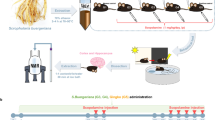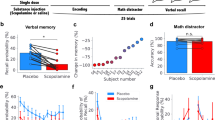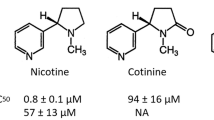Abstract
Establishing a pharmacologic model of the memory deficits of Alzheimer's disease could be an important tool in understanding how memory fails. We examined the combined effects of the muscarinic antagonist scopolamine and the nicotinic antagonist mecamylamine in eight normal elderly volunteers (age 61.9 ± 8.3 yrs, SD). Each received four separate drug challenges (scopolamine (0.4 mg IV), mecamylamine (0.2 mg/kg up to 15 mg PO), mecamylamine + scopolamine, and placebo). There was a trend toward increased impairment in explicit memory for the mecamylamine + scopolamine condition as compared to scopolamine alone. Increased impairment was also seen for the mecamylamine + scopolamine condition as compared to scopolamine alone in selected behavioral ratings. Pupil size increased when mecamylamine was added to scopolamine, while systolic blood pressure and pulse changed in concordance with ganglionic blockade. These data together with previous brain-imaging results suggest that this muscarinic–nicotinic drug combination may better model Alzheimer's disease than either drug alone.
Similar content being viewed by others
Log in or create a free account to read this content
Gain free access to this article, as well as selected content from this journal and more on nature.com
or
References
Beatty WW, Butters N, Janowsky DS . (1986): Patterns of memory failure after scopolamine treatment: Implications for cholingergic hypotheses of dementia. Behav Neural Biol 45: 196–211
Borkowski JG, Benton AL, Spreen O . (1967): Word fluency and brain damage. Neuropsychologia 5: 135–140
Bowen DM, Allen SJ, Benton JS, Goodhardt EA, Haan AM, Palmer NR, Sims NR, Smith CCT, Spillane JA, Esiri MM, Neary D, Snowdeon JS, Wilcock GK, Davison AN . (1983): Biochemical assessment of serotonergic and cholinergic dysfunction and cerebral atrophy in Alzheimer's disease. J Neurochem 41: 266–272
Brann MR, Ellis J, Jorgensen H, Hill-Eubanks D, Jones SV . (1993): Muscarinic acetylcholine receptor subtypes: Localization and structure/function. Prog Brain Res 98: 121–127
Broks P, Preston GC, Traub M, Poppleton P, Ward C, Stahl SM . (1988): Modeling dementia: Effects of scopolamine on memory and attention. Neuropsychologia 16: 685–700
Buschke H . (1973): Selective reminding for analysis of memory and learning. J Verb Learn Verb Behav 12: 543–550
Coyle JT, Price DL, DeLong MR . (1983): Alzheimer's disease: A disorder of cortical cholinergic innervation. Science 219: 1184–1190
Cozzolino R, Guaraldi D, Giuliani A, Chiradi O, Ramacci MT, Angelucci L . (1994): Effects of concomitant nicotinic and muscarinic blockade on spatial memory disturbance in rats are purely additive: Evidence from the Morris water task. Physiol Behav 56: 111–114
D'Amato RJ, Zweig RM, Whitehouse PJ, Wenk GL, Singer HS, Mayeux R, Price DL, Snyder SH . (1987): Aminergic systems in Alzheimer's disease and Parkinson's disease. Ann Neurol 22: 229–236
Davies P, Verth AH . (1978): Regional distribution of muscarinic acetylcholine receptor in normal and Alzheimer's-type dementia brains. Brain Res 138: 385–392
Davis KL, Thal LJ, Gamzu ER, Davis CS, Woolson RF, Gracon SI, Drachman DA, Schneider LS, Whitehouse PJ, Hoover TM, Morris JC, Kawas CH, Knopman DS, Earn NL, Kumar V, Doody RS . (1992): A double-blind, placebo-controlled multicenter study of tacrine for Alzheimer's disease. N Engl J Med 327: 1253–1259
Decker MW, Brioni JD, Bannon AW, Arneric SP . (1995): Diversity of neuronal nicotinic acetylcholine receptors: Lessons from behavior and implications for CNS therapeutics. Life Sci 56: 545–570
Dunne MP . (1990): Scopolamine and sustained retrieval from semantic memory. J Psychopharmacol 4: 13–18
Elrod K, Buccafusco J . (1991): Correlation of the amnestic effects of nicotinic antagonists with inhibition of regional brain acetylcholine synthesis in rats. J Pharmacol Exp Ther 258: 403–409
Farlow M, Gracon SI, Hershey LA, Lewis KW, Sadowsky CH, Dolan-Ureno J . (1992): A controlled trial of tacrine in Alzheimer's disease. JAMA 268: 2523–2529
Flicker C, Serby M, Ferris SH . (1990): Scopolamine effects on memory, language, visuospatial praxis, and psychomotor speed. Psychopharmacology 100: 243–250
Flynn DD, Mash DC . (1986): Characterization of L-[3H]nicotine binding in human cerebral cortex: Comparison between Alzheimer's disease and the normal. J Neurochem 47: 1948–1954
Freis ED . (1955): Mecamylamine in hypertension. Lancet 2: 977
Freis ED, Wilson IM . (1956): Mecamylamine, a new orally effective, hypotensive agent. Arch Intern Med 97: 551–561
Friedland RP, Jagust WH, Huesman RH, Koss E, Knottel B, Mathis CA, Ober BA, Mazoyer BM, Budinger TF . (1989): Regional cerebral glucose transport and utilization in Alzheimer's disease. Neurology 39: 1427–1434
Gitelman DR, Prohovnik I . (1992): Muscarinic and nicotinic contributions to cognitive function and cortical blood flow. Neurobiol Aging 13: 313–318
Grober E, Sliwinski M . (1991): Development and validation of a model for estimating premorbid verbal intelligence in the elderly. J Clin Exp Neuropsychol 13: 933–949
Haxby JV, Grady CL, Koss E, Horwitz B, Schapiro M, Friedland RP, Rapoport SI . (1988): Heterogeneous anterior–posterior metabolic patterns in dementia of the Alzheimer type. Neurology 38: 1853–1863
Kellar KJ, Whitehouse PJ, Martino-Barrows AM, Marcus K, Price DL . (1987): Muscarinic and nicotinic cholinergic binding sites in Alzheimer's disease cerebral cortex. Brain Res 436: 62–68
Knapp MJ, Knopman DS, Solomon PR, Pendlebury WW, Davis CS, Gracon SI . (1994): A 30-week randomized controlled trial of high-dose tacrine in patients with Alzheimer's disease. The Tacrine Study Group. JAMA 271: 985–991
Kucera H, Francis WN . (1967): Computational Analysis of Present-Day American English. Providence, RI, Brown University Press
Kumar A, Schapiro MB, Grady C, Haxby JV, Wagner E, Salerno JA, Friedland RP, Rapoport SI . (1991): High-resolution PET studies in Alzheimer's disease. Neuropsychopharmacology 4: 35–46
Lapchak PA, Araujo DM, Quirion R, Collier B . (1989a): Effect of chronic nicotine treatment on nicotinic autoreceptor function and N-[3H]methylcarbamycholine binding sites in the rat brain. J Neurochem 52: 483–491
Lapchak PA, Araujo DM, Quirion R, Collier B . (1989b): Presynaptic cholinergic mechanisms in the rat cerebellum: Evidence for nicotinic, but not muscarinic autoreceptors. J Neurochem 53: 1843–1851
Levin ED . (1992): Nicotinic systems and cognitive function. Psychopharmacology (Berl) 108: 417–431
Levin ED, McGurk SR, South D, Butcher LL . (1989): Effects of combined muscarinic and nicotinic blockade on choice accuracy in the radial-arm maze. Behav Neural Biol 51: 270–277
Levin ED, Rose JE, McGurk SR, Butcher LL . (1990): Characterization of the cognitive effects of combined muscarinic and nicotinic blockade. Behav Neural Biol 53: 103–112
Martin BR, Onaivi ES, Martin TJ . (1989): What is the nature of mecamylamine's antagonism of the central effects of nicotine? Biochem Pharmacol 38: 3391–3397
Martin TJ, Suchocki J, May EL, Martin BR . (1990): Pharmacological evaluation of the antagonism of nicotine's central effects by mecamylamine and pempidine. J Pharmacol Exp Ther 254: 45–51
Mash DC, Flynn DD, Potter LT . (1985): Loss of M2 muscarine receptors in the cerebral cortex in Alzheimer's disease and experimental cholinergic denervation. Science 228: 1115–1117
Mattis S . (1976): Mental status examination for organic mental syndrome in the elderly patient. In Bellak L, Karasu TB (eds), Geriatric Psychiatry. New York, Grune & Stratton, pp 77–121
Molchan SE, Martinez RA, Hill JL, Weingartner HJ, Thompson K, Vitiello B, Sunderland T . (1992): Increased cognitive sensitivity to scopolamine with age and a perspective on the scopolamine model. Brain Res Rev 17: 215–226
Moyer J, Heider C, Dennis E . (1957): Mecamylamine (inversine) in the treatment of hypertension. JAMA 164: 1879–1886
Murphy DL, Mueller EA, Hill JL, Tolliver RJ, Jacobsen FM . (1989): Comparative anxiogenic, neuroendocrine, and other physiologic effects of m-chlorophenylpiperazine given intravenously or orally to healthy volunteers. Psychopharmacology 98: 275–282
Nebes RD . (1992): Cognitive dysfunction in Alzheimer's disease. In Craik FIM, Salthouse TA (eds), Handbook of Cognitive Aging. Hillsdale, New Jersey, Lawrence Erlbaum Associates, pp 373–446
Newhouse PA, Potter A, Corwin J, Lenox R . (1992): Acute nicotinic blockade produces cognitive impairment in normal humans. Psychopharmacology 108: 480–484
Newhouse PA, Potter A, Corwin J, Lenox R . (1994): Age-related effects of the nicotinic antagonist mecamylamine on cognition and behavior. Neuropsychopharmacology 10: 93–107
Nordberg A, Hartvig P, Lilja A, Viitanen M, Amberla K, Lundqvist H, Andersson Y, Ulin J, Winblad B, Langstrom B . (1990): Decreased uptake and binding of 11C-nicotine in brain of Alzheimer patients as visualized by positron emission tomography. J Neural Transm 2: 215–224
Nordberg A, Alafuzoff I, Winblad B . (1992): Nicotinic and muscarinic subtypes in the human brain: Changes with aging and dementia. J Neurosci Res 31: 103–111
Overall JE, Beller SA . (1984): The brief psychiatric rating scale (BPRS) in geropsychiatric research: I. Factor structure on an inpatient unit. J Gerontol 39: 187–193
Overall JE, Gorham DR . (1962): The brief psychiatric rating scale. Psychol Rep 10: 799–812
Perry EK, Smith CJ, Court JA, Perry RH . (1990): Cholinergic nicotinic and muscarinic receptors in dementia of Alzheimer, Parkinson, and Lewy body types. J Neural Transm 2: 149–158
Prohovnik I, Mayeux R, Sackheim HA, Smith G, Stern Y, Alderson PO . (1988): Cerebral perfusion as a diagnostic marker of early Alzheimer's disease. Neurology 38: 931–937
Riekkinen PJ, Sirvio J, Aaltonen M, Riekkinen P . (1990): Effects of concurrent manipulations of nicotinic and muscarinic receptors on spatial and passive avoidance learning. Pharmacol Biochem Behav 37: 405–410
Rogers SL, Friedhoff LT, and the Donepezil Study Group (1996): The efficacy and safety of donepezil in patients with Alzheimer's Disease: results of a US multicentre, randomized, double-blind, placebo-controlled trial. Dementia 7: 293–303
Scinto LF, Daffner KR, Dressler D, Ransil BI, Rentz D, Weintraub S, Mesulam M, Potter H . (1994): A potential noninvasive neurobiological test for Alzheimer's disease. Science 266: 1051–1054
Shimohama S, Taniguchi T, Fjuiwara M, Kameyama M . (1986): Changes in nicotinic and muscarinic cholinergic receptors in Alzheimer-type dementia. J Neurochem 46: 288–293
Smirk FH, McQueen EG . (1957): Use of mecamylamine in the management of hypertension. Br Med J 422–425
Stolerman IP, Goldfarb T, Fink R, Jarvik ME . (1973): Influencing cigarette smoking with nicotine antagonists. Psychopharmacologia 28: 247–259
Sunderland T, Molchan SE, Martinez RA, Vitiello B, Martin P . (1990): Drug challenge strategies in Alzheimer's disease: A focus on the scopolamine model. In Becker RE, Giacobini E, (eds), Alzheimer's Disease: Current Research in Early Diagnosis. New York, Taylor & Francis Publishers, pp 173–181
Sunderland T, Tariot PN, Cohen RM, Weingartner H, Mueller EA, Murphy DL . (1987): Anticholinergic sensitivity in patients with dementia of the Alzheimer type and age-matched controls: A dose-response study. Arch Gen Psychiatry 44: 418–426
Sunderland T, Tariot PN, Weingartner H, Murphy DL, Newhouse PA, Mueller EA, Cohen RM . (1986): Pharmacologic modeling of Alzheimer's disease. Prog Neuro-Psychopharmacol Biol Psychiatry 10: 599–610
Takayama H, Majewska MD, London ED . (1989): Interactions of noncompetitive inhibitors with nicotinic receptors in the rat brain. J Pharmacol Exp Ther 253: 1083–1089
Van Kammen DP, Murphy DL . (1975): Attenuation of the euphoriant and activating effects of d- and l-amphetamine by lithium carbonate treatment. Psychopharmacolgia 44: 215–224
Wang S-Z, Zhu S-Z, Mash DC, El-Fakahany EE . (1992): Comparison of the concentration of messenger RNA encoding four muscarinic receptor subtypes in control and Alzheimer brains. Molec Brain Res 16: 64–70
Wechsler D . (1987): Wechsler Memory Scale—Revised Manual. San Antonio, TX, The Psychological Corp., Harcourt Brace, Inc.
Whitehouse PJ, Au KS . (1986): Cholinergic receptors in aging and Alzheimer's disease. Prog Neuro-Psychopharmacol Biol Psychiatry 10: 665–676
Whitehouse PJ, Martino AM, Antuono PG, Lowenstein PR, Coyle JT, Price DL, Keller KJ . (1986): Nicotinic acetylcholine binding sites in Alzheimer's disease. Brain Res 371: 146–151
Zubenko GS, Moossy J, Hanin I, Martinez AJ, Rao GR, Kopp U . (1988): Bilateral symmetry of cholinergic deficits in Alzheimer's disease. Arch Neurol 45: 255–259
Acknowledgements
The authors thank Wilma Davis, Kathleen Dietrich, R.N., Charyl Staso, R.N., Julie Jaffe, Jeanne Radcliffe, R.N., and the nursing staff on NIH Clinical Center Nursing Unit 3 East for their help with this project.
Author information
Authors and Affiliations
Rights and permissions
About this article
Cite this article
Little, J., Johnson, D., Minichiello, M. et al. Combined Nicotinic and Muscarinic Blockade in Elderly Normal Volunteers: Cognitive, Behavioral, and Physiologic Responses. Neuropsychopharmacol 19, 60–69 (1998). https://doi.org/10.1016/S0893-133X(98)00002-5
Received:
Revised:
Accepted:
Issue date:
DOI: https://doi.org/10.1016/S0893-133X(98)00002-5
Keywords
This article is cited by
-
EEG machine learning for accurate detection of cholinergic intervention and Alzheimer’s disease
Scientific Reports (2017)
-
A test of the cognitive-enhancing potential of low-dose mecamylamine in healthy non-smokers
Psychopharmacology (2017)
-
Associations between a neurophysiological marker of central cholinergic activity and cognitive functions in young and older adults
Behavioral and Brain Functions (2012)
-
Change is in the eye of the beholder
Nature Neuroscience (2012)
-
Modes and Models of Forebrain Cholinergic Neuromodulation of Cognition
Neuropsychopharmacology (2011)



